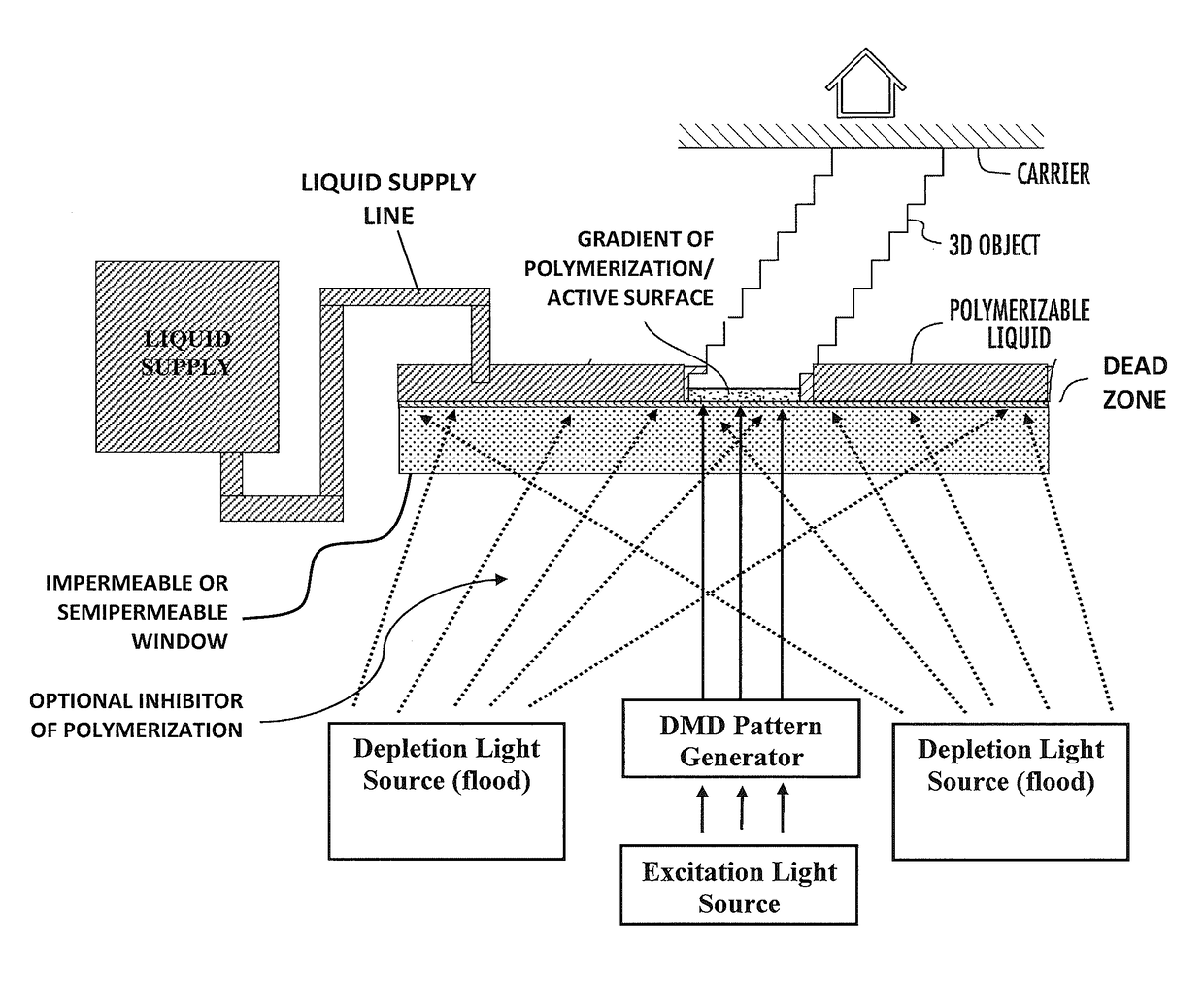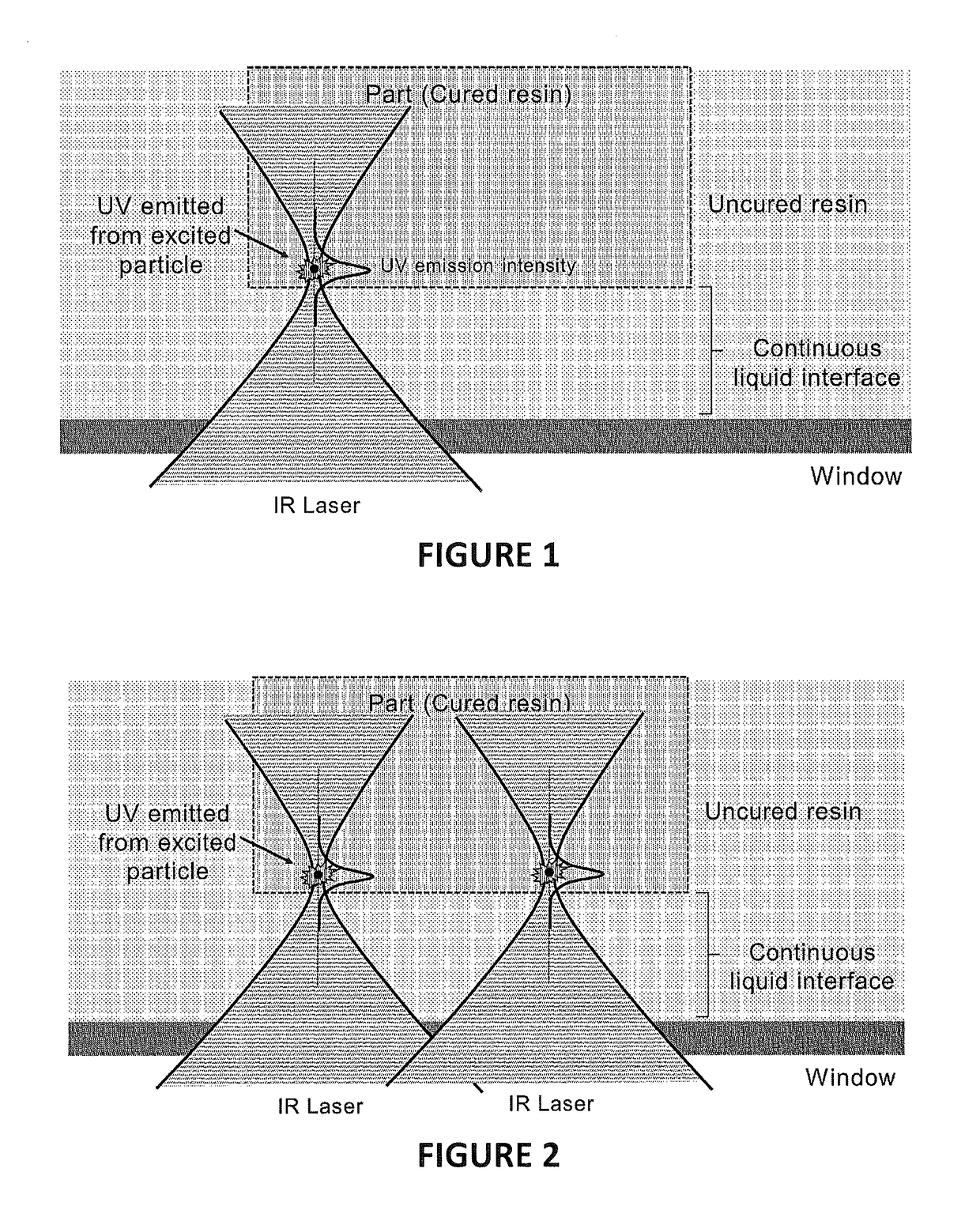Continuous liquid interface production with upconversion photopolymerization
a technology of photopolymerization and liquid interface, which is applied in the direction of metal-working equipment, additive manufacturing, manufacturing tools, etc., can solve the problems of needing to submerge, extreme care, and use of additional mechanical elements
- Summary
- Abstract
- Description
- Claims
- Application Information
AI Technical Summary
Benefits of technology
Problems solved by technology
Method used
Image
Examples
first embodiment
[0086]FIG. 1 illustrates a method of producing a three dimensional object, while maintaining a continuous liquid interface, the method utilizing upconversion particles (as described above) in the resin. In this embodiment, resin is held in a container above an optically transparent, gas impermeable (and specifically oxgen impermeable), window (e.g., glass or sapphire). The resin is irradiated with infrared light focused with a high numerical aperture to generate a high intensity focal spot with short depth of focus at a location away from the window in the resin (e.g., 10 or 20 to 100 or 200 or 1000 to 10000 um above the window). The cure rate of the resin is only appreciable near the focal spot, so curing occurs only near the focal spot and an uncured, liquid, resin layer is continuously maintained near the window, while the part is continuously or intermittently advanced away from the window to form the three-dimensional object. Concurrently or sequentially with the advancement of...
second embodiment
[0115]FIGS. 9A-9B schematically illustrate a dual wavelength scheme, in which, in which (i) the overall depletion intensity is relatively high, but is not uniform (is spatially modulated). Specifically, the center pixel receives low intensity depletion light (not shown), as in FIG. 8A, while the surrounding eight pixels receive higher intensity depletion light. There is some optical overlap between the pixels (e.g., achieved by slight defocusing). The polymerized size of the feature or segment of the object polymerized by the center pixel is smaller, due to the depletion beam spilling over into excitation beam, yet remains centered in the horizontal dimension of the object, relative to the pixels delivering light, because of the equal intensity of the depletion light delivered in the surrounding pixels.
third embodiment
[0116]FIGS. 10A-10B schematically illustrate a dual wavelength scheme, in which (i) the depletion intensity is both high and low (spatially modulated). Specifically, the center pixel, and the pixels on the right, receive low intensity depletion light, while the pixels to the left, and above and below the center pixel, receive higher intensity depletion light. Again there is some optical overlap between the pixels (e.g., achieved by slight defocusing). The polymerized size of the feature or segment of the object polymerized by the center pixel is smaller and shifted to the right, due to the depletion beam spilling over in an unequal or offset manner into the excitation beam.
[0117]While the dead zone and the gradient of polymerization zone do not have a strict boundary therebetween (in those locations where the two meet), the thickness of the gradient of polymerization zone is in some embodiments at least as great as the thickness of the dead zone. Thus, in some embodiments, the dead ...
PUM
| Property | Measurement | Unit |
|---|---|---|
| wavelength | aaaaa | aaaaa |
| wavelength | aaaaa | aaaaa |
| wavelength | aaaaa | aaaaa |
Abstract
Description
Claims
Application Information
 Login to View More
Login to View More - R&D
- Intellectual Property
- Life Sciences
- Materials
- Tech Scout
- Unparalleled Data Quality
- Higher Quality Content
- 60% Fewer Hallucinations
Browse by: Latest US Patents, China's latest patents, Technical Efficacy Thesaurus, Application Domain, Technology Topic, Popular Technical Reports.
© 2025 PatSnap. All rights reserved.Legal|Privacy policy|Modern Slavery Act Transparency Statement|Sitemap|About US| Contact US: help@patsnap.com



